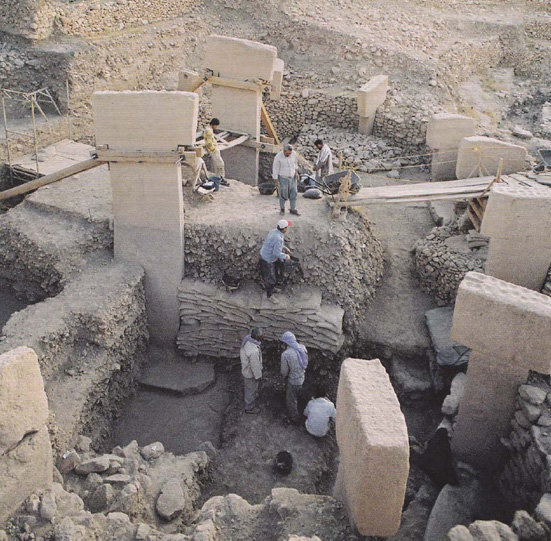It looks like you're using an Ad Blocker.
Please white-list or disable AboveTopSecret.com in your ad-blocking tool.
Thank you.
Some features of ATS will be disabled while you continue to use an ad-blocker.
24
share:
An interesting suggestion by Giulio Magli is that the monuments of Gobekli tepe were aligned to the rising point of Sirius, particularly so because at
that latitude Sirius had only just began to be visible above the Southern horizon after a prolonged absence due to precessional effect
Sirius and the project of the megalithic enclosures at Gobekli Tepe
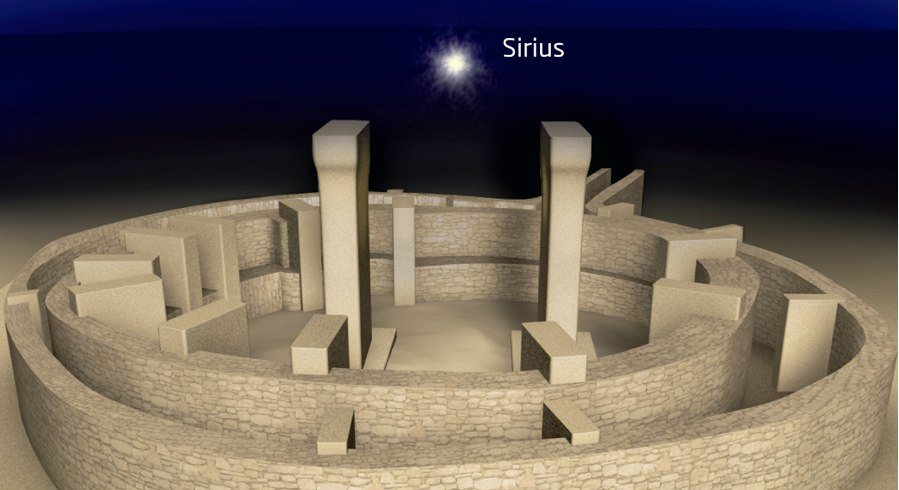
So this would be Sirius as herald of a new age as it were, and over the millenia it would continue to rise ever higher into the skies of the Northern hemisphere, achieving maximum elevation at the present thereabouts.
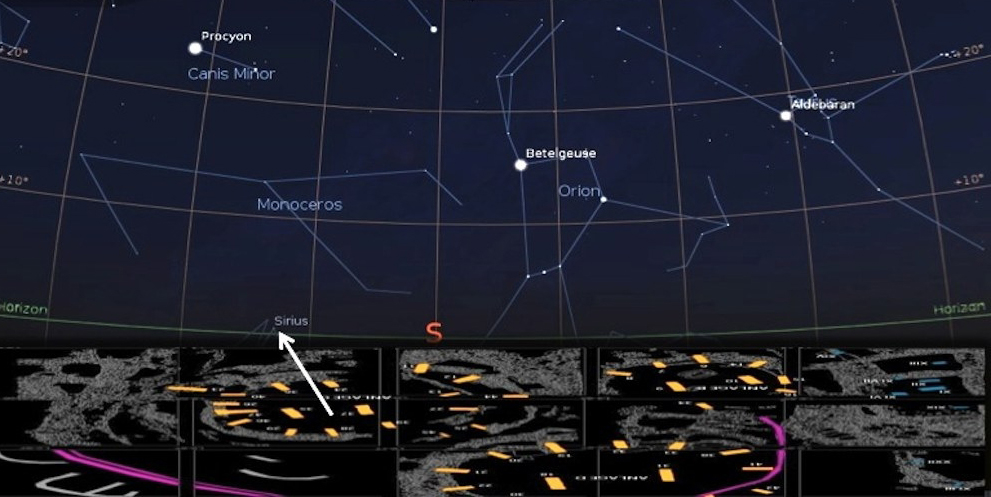
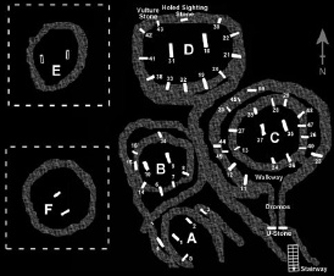 So what he is saying is that enclosures were added in accordance with the shifting
rising point of Sirius according to precession, but it can also be seen that the former alignment to Sirius has become an alignment to Orions belt,
others have considered alignment to that and to some degree the monument can be considered to both at the same time, and not necessarily one or the
other.
So what he is saying is that enclosures were added in accordance with the shifting
rising point of Sirius according to precession, but it can also be seen that the former alignment to Sirius has become an alignment to Orions belt,
others have considered alignment to that and to some degree the monument can be considered to both at the same time, and not necessarily one or the
other.
He looks toward other alignments such as toward the Summer Solstice, and the origins of an interest in the helical rise of Sirius;
So anyway i find this all very interesting and it would explain quite a few traditions of later times...
The megalithic enclosures of Gobekli Tepe are the most ancient stone-built sacred structures known so far, dating back to the 10th millennium BC. The possible presence of astronomical targets for these structures is analysed, and it turns out that they may have been
oriented – or even originally constructed - to “celebrate” and successively follow the appearance of a “new”, extremely brilliant star in the southern skies: Sirius.
Sirius and the project of the megalithic enclosures at Gobekli Tepe

So this would be Sirius as herald of a new age as it were, and over the millenia it would continue to rise ever higher into the skies of the Northern hemisphere, achieving maximum elevation at the present thereabouts.
In fact, simulating the sky in the 10th millennium BC, it is possible to see that a quite spectacular phenomenon occurred at Gobekli Tepe
in that period: the “birth” of a “new” star, and certainly not of an ordinary one, as it is the brightest star and the 4th most brilliant object of the sky: Sirius. Indeed precession, at the latitude of Gobekli Tepe, brought Sirius under the horizon in the years around 15000 BC. After reaching the minimum, Sirius started to come closer to the horizon and it became visible again, very low and close to due south, towards 9300 BC.

...the extrapolated mean azimuths of the structures (taken as the mid-lines between the two central monoliths) are estimated
as follows:
Structure D 172°
Structure C 165°
Structure B 159°
As Sirius is a negative magnitude star, it is in principle visible just above the horizon; I will however allow in what follows an altitude of ½ ° (actually the horizon at the site estimated via satellite images looks flat towards the south-east). Then, it can be seen that the above azimuths match the rising azimuths of Sirius in the following approximate dates:
Structure D 172° 9100 BC
Structure C 165° 8750 BC
Structure B 159° 8300 BC
 So what he is saying is that enclosures were added in accordance with the shifting
rising point of Sirius according to precession, but it can also be seen that the former alignment to Sirius has become an alignment to Orions belt,
others have considered alignment to that and to some degree the monument can be considered to both at the same time, and not necessarily one or the
other.
So what he is saying is that enclosures were added in accordance with the shifting
rising point of Sirius according to precession, but it can also be seen that the former alignment to Sirius has become an alignment to Orions belt,
others have considered alignment to that and to some degree the monument can be considered to both at the same time, and not necessarily one or the
other. He looks toward other alignments such as toward the Summer Solstice, and the origins of an interest in the helical rise of Sirius;
As a final observation, it should be noted that a further structure uncovered at Gobekli Tepe has an estimated azimuth of 59° (if it was open to the north-east, as it seems) which is pretty close to that of the rising sun at the summer solstice.
On the pillar 43 of enclosure D a suggestive, unique scene is represented: a sort of vulture with human traits delicately “rises up” with a wing what seems to be a sphere, or a disk. May this be a representation of the Heliacal rising of the newly born star we today call Sirius, which – as can be easily verified - occurred just a few days before the summer solstice at the end of the 10th millennium BC at the latitude of Gobekli Tepe?
So anyway i find this all very interesting and it would explain quite a few traditions of later times...
a reply to: Kantzveldt
The question to ask of what value is that alignment to a person of that time?
Well its an engaging theory but I would tend to believe if the sites are oriented anywhere it would be to the rising sun that shows seasons which would have been of value to them.
The problem with associating stars to be alignment points is that there are lots of points in the sky and they shift around (highly simplified) a lot so you can find an alignment virtually anywhere.
Great stuff as always Kantzveldt.
The question to ask of what value is that alignment to a person of that time?
Well its an engaging theory but I would tend to believe if the sites are oriented anywhere it would be to the rising sun that shows seasons which would have been of value to them.
The problem with associating stars to be alignment points is that there are lots of points in the sky and they shift around (highly simplified) a lot so you can find an alignment virtually anywhere.
Great stuff as always Kantzveldt.
originally posted by: Hanslune
The problem with associating stars to be alignment points is that there are lots of points in the sky and they shift around (highly simplified) a lot so you can find an alignment virtually anywhere.
Exactly. Because of the constant shifting and rotation of the Earth, alignments never really point at specific stars, but rather draw arcs that cross the entire sky. And looking at the positions of the stones at the site, it looks like most of them are more likely aligned to support a roof structure. Besides, why only align some of the larger stones, and not all of them?
This is one of those cases where "fudging" becomes a significant factor in proving associations.
a reply to: Hanslune
The potential significance and my own interest here develops from observing that the Sumerian Goddess Bau had a Post-Diluvian role in the mythology, the restoration to life and provisions in abundance and a general raising of the spirits, as well as the generation of mankind from seed, she also strongly identifies with the star Sirius.
Now in looking for an historical premise for a mass extermination event the last ice age and subsequent localized flooding is really the only candidate, the Aryan tradition of Yima and his Vara buried under the ice and snow, in which was preserved the seed of all living things is a Northerly version of such catastrophe, and probably the closest to the mark, so survival was passed down in folklore.
Now of course for any Goddess to have had Post-Diluvian origins and relating to Sirius the star itself would have to have been visible, and so the date when this would have been possible emerges as around 11,500 years ago for the latitude of Turkey and that corresponds to the radical changes seen at Gobekli Tepe, thus Sirius could well have been associated with Post-Diluvian re-establishment of populations in the Northern hemisphere, indeed as the very Goddess of such.
a reply to: Blue Shift
Alignments can point to specific rising points of stars at a certain date...
The potential significance and my own interest here develops from observing that the Sumerian Goddess Bau had a Post-Diluvian role in the mythology, the restoration to life and provisions in abundance and a general raising of the spirits, as well as the generation of mankind from seed, she also strongly identifies with the star Sirius.
Now in looking for an historical premise for a mass extermination event the last ice age and subsequent localized flooding is really the only candidate, the Aryan tradition of Yima and his Vara buried under the ice and snow, in which was preserved the seed of all living things is a Northerly version of such catastrophe, and probably the closest to the mark, so survival was passed down in folklore.
Now of course for any Goddess to have had Post-Diluvian origins and relating to Sirius the star itself would have to have been visible, and so the date when this would have been possible emerges as around 11,500 years ago for the latitude of Turkey and that corresponds to the radical changes seen at Gobekli Tepe, thus Sirius could well have been associated with Post-Diluvian re-establishment of populations in the Northern hemisphere, indeed as the very Goddess of such.
a reply to: Blue Shift
Alignments can point to specific rising points of stars at a certain date...
edit on Kpm1231341vAmerica/ChicagoMonday0831 by Kantzveldt
because: (no reason given)
a reply to: Kantzveldt
However we have no idea if those later Sumerian ideas even existed then or that the people of GT knew of them if other did (language barrier).
What is the oldest attribution do we have for this god? Does it show up fully formed or does it evolve?
However we have no idea if those later Sumerian ideas even existed then or that the people of GT knew of them if other did (language barrier).
What is the oldest attribution do we have for this god? Does it show up fully formed or does it evolve?
a reply to: Hanslune
Of course the Sumerian ideas as such couldn't have existed back then, there is a 6,000 year differential in dates, but in identifying the God Ninurta with Sirius and the causation of the Deluge and his consort Bau with the Post-Deluge mopping up operation they at least suggest that star was in some way associated.
So if we say take the disappearance of Sirius circa 15,000 years ago with the onset of the period of catastrophe and the return of the stars visibility some 11,500 years ago as new beginings under it's auspicious blessings we can perhaps perceive how that star came to be associated with those epochs, and all of it's later mythological associations must find first context when it returned to visibility, and the events that were taking place at that time with which it became synonymous.
Of course it would be a thing of wonder if such associations did survive into the historic period and were remembered in the mythology, but i think there is every chance that is the case.
Of course the Sumerian ideas as such couldn't have existed back then, there is a 6,000 year differential in dates, but in identifying the God Ninurta with Sirius and the causation of the Deluge and his consort Bau with the Post-Deluge mopping up operation they at least suggest that star was in some way associated.
So if we say take the disappearance of Sirius circa 15,000 years ago with the onset of the period of catastrophe and the return of the stars visibility some 11,500 years ago as new beginings under it's auspicious blessings we can perhaps perceive how that star came to be associated with those epochs, and all of it's later mythological associations must find first context when it returned to visibility, and the events that were taking place at that time with which it became synonymous.
Of course it would be a thing of wonder if such associations did survive into the historic period and were remembered in the mythology, but i think there is every chance that is the case.
a reply to: Kantzveldt
Interesting and well done as always. Thanks for the post! Here is a picture of pillar 43 of enclosure D, the "vulture stone."
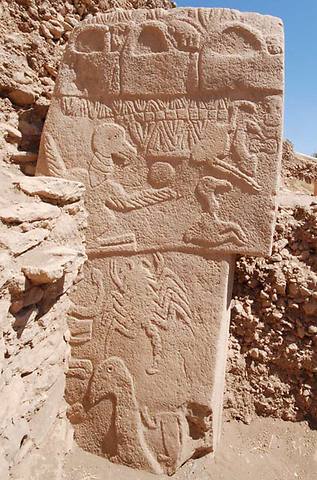
Interesting and well done as always. Thanks for the post! Here is a picture of pillar 43 of enclosure D, the "vulture stone."

edit on 2014-12-8 by theantediluvian because: (no reason given)
a reply to: Kantzveldt
It is possible but is it probably and plausible?
Unfortunately I can think of no way to demonstrate the later two, good theory thou!
It is possible but is it probably and plausible?
Unfortunately I can think of no way to demonstrate the later two, good theory thou!
For people who might not have had much to do at night might have found it quite profound to see a new "birth". Seeing how much veneration was placed
on stars in general, to witness a birth and feel the need or want to comemerate and pay homage would seem practical.
I think what amazes me most about our ancient past is how amazingly captivating to so many people now thousands of years later. I just love being awed by the awesomeness that is our past.
I think what amazes me most about our ancient past is how amazingly captivating to so many people now thousands of years later. I just love being awed by the awesomeness that is our past.
a reply to: Hanslune
Yes i think it's very likely because of the mythological associations Sirius retained, death and rebirth, and association with inundation, Ninurta apart from being the God of the Deluge also was responsible for the creation of dams and levees and irrigation systems, his wife monitored the levees, again in Egypt one finds those corresponding traditions of flood and irrigation in connection with Sirius. Once it was determined what the star related to it was unlikely to lose it's significance without good reason, particularly given the enormous importance attached to those events in regions affected.
a reply to: Rosinitiate
It is a truly epic tale and of course it was an ongoing one as the star continued to gain elevation in the skies from those early new beginings and the re-population and development of the Northern hemisphere, so a success story, a Goddess that works
Yes i think it's very likely because of the mythological associations Sirius retained, death and rebirth, and association with inundation, Ninurta apart from being the God of the Deluge also was responsible for the creation of dams and levees and irrigation systems, his wife monitored the levees, again in Egypt one finds those corresponding traditions of flood and irrigation in connection with Sirius. Once it was determined what the star related to it was unlikely to lose it's significance without good reason, particularly given the enormous importance attached to those events in regions affected.
a reply to: Rosinitiate
It is a truly epic tale and of course it was an ongoing one as the star continued to gain elevation in the skies from those early new beginings and the re-population and development of the Northern hemisphere, so a success story, a Goddess that works
edit on Kpm1231341vAmerica/ChicagoMonday0831 by Kantzveldt because: (no reason given)
a reply to: Kantzveldt
I would suppose that some posters here are familiar with the book The Sirius Mystery by Robert K.G. Temple? It tells of how ETs from Sirius visited African tribes thousands of years ago as passed down from oral stories.
Having a history with UFOs, I'm always distrustful of any science that tends to insist that human activity (including honored gods seemingly created in human minds) is the sole answer to every mystery we attempt to explain. I think the cosmos always allows a wider perspective if one choses to disallow man's omnipotence over all.
I would suppose that some posters here are familiar with the book The Sirius Mystery by Robert K.G. Temple? It tells of how ETs from Sirius visited African tribes thousands of years ago as passed down from oral stories.
Having a history with UFOs, I'm always distrustful of any science that tends to insist that human activity (including honored gods seemingly created in human minds) is the sole answer to every mystery we attempt to explain. I think the cosmos always allows a wider perspective if one choses to disallow man's omnipotence over all.
That image of the two pillars with Sirius in between reminds me of a Masonic image. Probably just a coincidence, but who knows there may be a
connection.
Kinda like these agdei.com...
Could not embed for some reason.
Kinda like these agdei.com...
Could not embed for some reason.
edit on 12/9/2014 by 3n19m470 because: (no reason given)
Sorry Doublepost
edit on 9-12-2014 by Spider879 because: (no reason given)
Another hunter gather folk did mark Sirius at about the same time although not anywhere nearly as grand as G.T they also pointed to that bright star
,these off-course were the people at Nabta Playa their Goddess figure would have been Hathor but according to some views floating around the net
there may have been some connection with G.T in an earlier thread I touched up on the possibility of a Saharan connection with G.T without referencing
N.P
www.andrewcollins.com...#
Cosmic Birth
Almost exactly what we see represented in abstract form on the sighting stone in Göbekli Tepe's Enclosure D is found also on the Venus and Sorcerer panel inside France's Chauvet cave, created by a Paleolithic artist some 32,000-30,000 years ago. Here too the abstract legs of the "Venus" seem to signify the twin streams of the Milky Way either side of the Dark Rift, with the head of a young bovine overlaid upon the position of the womb. This bucranium is likely to represent the Cygnus constellation in its role as the head of a bull calf, which in prehistoric times was seen as an abstract representation of the female womb or uterus complete with its horn-like fallopian tubes. The uncanny likeness between the two is something that our distant ancestors would appear to have realized at a very early stage in human development.(23) We are reminded also of the 3D frescoes from Çatal Höyük showing bulls being born from between the legs of divine females (often with the heads of leopards), and the ancient Egyptian belief that the goddess Hathor, in her role as the Milky Way, gave birth each morning to the sun-god in the form of a bull calf, which was seen to emerge from between twin sycamore trees perhaps signifying the twin streams created by the Dark Rift.
www.andrewcollins.com...#
a reply to: Aliensun
His research on the Sumerian angle for that book was surprisingly good given the difficulties in putting a cohesive picture together at that time;
Sirius Mystery
a reply to: 3n19m470
It's not a coincidence, the Free Masons got the motif from Jewish Kabbalists who in turn had got it from familiarity with the Assyrian and Babylonian tree of life representations.
The Starway to Sirius
a reply to: Spider879
It's interesting because Andrew Collins having wrote books on a Cygnus correlation to the Gizamids has not unsurprisingly counter claimed that the Gobekli Tepe alignments point to Cygnus in the North West, that is unlikely because the enclosures open up to the South East and there is a hill behind them blocking any such alignment, however the Celestial axis of the Sumerians according to my own research was an enormous affair with Sirius at it's pinnacle and the constellations Pegasus (and Cygnus) at it's base, covering the entire extent of the sky the base is always opposite to the summit, so the positioning of Cygnus is relevant though that is not what is aligned toward.
Andrew Collins on Gobekli Tepe
The Celestial Tree
His research on the Sumerian angle for that book was surprisingly good given the difficulties in putting a cohesive picture together at that time;
Since An is connected with Sirius, we should thus not be surprised that he has a dog-goddess for a daughter in Sumer. Sirius as the Dog Star was a tradition which was not thought to have existed in Sumer, however, before now.
Since the fifty Anunnaki were children of An, and Bau is a daughter of An, it is not far-fetched to see in Bau a survival (for she is an old goddess who faded into obscurity in later times) of the concept of a dog-star goddess equivalent to Sothis.
Enlil, whose command is far-reaching, whose word is holy, The lord whose pronouncement is unchangeable, who forever decrees destinies, Whose lifted eye scans the lands, Whose lifted light searches the heart of all the lands,
Sirius Mystery
a reply to: 3n19m470
It's not a coincidence, the Free Masons got the motif from Jewish Kabbalists who in turn had got it from familiarity with the Assyrian and Babylonian tree of life representations.
The Starway to Sirius
a reply to: Spider879
It's interesting because Andrew Collins having wrote books on a Cygnus correlation to the Gizamids has not unsurprisingly counter claimed that the Gobekli Tepe alignments point to Cygnus in the North West, that is unlikely because the enclosures open up to the South East and there is a hill behind them blocking any such alignment, however the Celestial axis of the Sumerians according to my own research was an enormous affair with Sirius at it's pinnacle and the constellations Pegasus (and Cygnus) at it's base, covering the entire extent of the sky the base is always opposite to the summit, so the positioning of Cygnus is relevant though that is not what is aligned toward.
Andrew Collins on Gobekli Tepe
The Celestial Tree
edit on Kam1231342vAmerica/ChicagoTuesday0931 by Kantzveldt
because: (no reason given)
new topics
-
Oh, Good Gosh. “Kremlin Warns Stay Away from Greenland.”
World War Three: 1 hours ago -
Archbisop Vigano Warns of Deep State and Deep Church
New World Order: 1 hours ago -
A Flash of Beauty: Bigfoot Revealed ( documentary )
Cryptozoology: 7 hours ago -
Fire insurance in LA withdrawn months ago
General Conspiracies: 9 hours ago
top topics
-
Fire insurance in LA withdrawn months ago
General Conspiracies: 9 hours ago, 8 flags -
A Flash of Beauty: Bigfoot Revealed ( documentary )
Cryptozoology: 7 hours ago, 6 flags -
Oh, Good Gosh. “Kremlin Warns Stay Away from Greenland.”
World War Three: 1 hours ago, 4 flags -
Archbisop Vigano Warns of Deep State and Deep Church
New World Order: 1 hours ago, 3 flags
active topics
-
Los Angeles brush fires latest: 2 blazes threaten structures, prompt evacuations
Mainstream News • 300 • : 38181 -
Trump says ownership of Greenland 'is an absolute necessity'
Other Current Events • 93 • : bastion -
Fire insurance in LA withdrawn months ago
General Conspiracies • 26 • : sapien1982 -
Oh, Good Gosh. “Kremlin Warns Stay Away from Greenland.”
World War Three • 7 • : DAVID64 -
The Truth about Migrant Crime in Britain.
Social Issues and Civil Unrest • 45 • : covent -
Judge rules president-elect Donald Trump must be sentenced in 'hush money' trial
US Political Madness • 87 • : tkwaz -
A Flash of Beauty: Bigfoot Revealed ( documentary )
Cryptozoology • 4 • : CosmicFocus -
Archbisop Vigano Warns of Deep State and Deep Church
New World Order • 0 • : FlyersFan -
Planned Civil War In Britain May Be Triggered Soon
Social Issues and Civil Unrest • 33 • : sapien1982 -
Steering the Titantic from the Drydock.
Rant • 47 • : andy06shake
24

